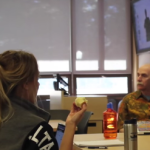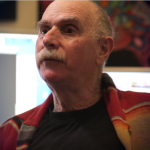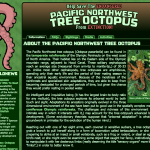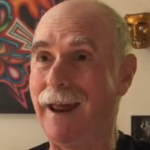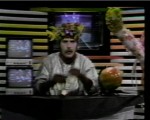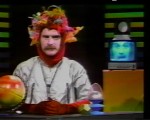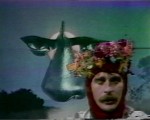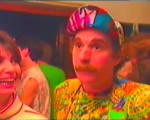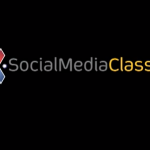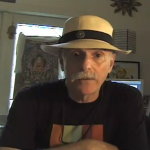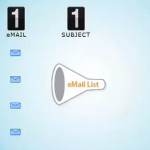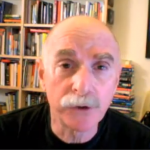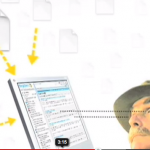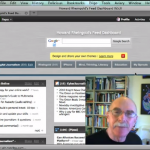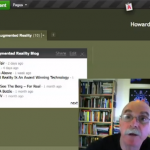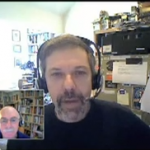What I learned from Howard Rheingold (November 2019)
In February, 2017, at my art opening at Institute for the Future, Justin Hall interviewed 10 of my friends to hear what they learned from me.
Thank you to my two most influential teachers (March, 2016)
Howard Rheingold: On To the Next Chapter
Four minute student video on Howard’s retirement from Stanford (2015)
On Network Know-How as An Essential Literacy (2013)
Net Smart: How to Thrive Online
Ten minute description of essential media literacies (March, 2016)
Howard at Utrecht University (2013)
Howard at MIT Media Lab (2012)
Mamie Rheingold Interviews Howard Rheingold at Google (2012)
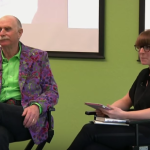
Net Smart Trailer (2012)
This one-minute video introduces my book, Net Smart: How to Thrive Online.
Crap Detection 101 (2010)
Before I wrote the chapter for Net Smart, I made this video/screencast, demonstrating elementary crap detection methods.
Innovation and the Commons (2007)
Extraterrestrial Anthropology
The Martian Report (1976)
In 1976, Jim Neidhardt put one of the first Sony Portapaks in a backpack and used a telephoto lens. Equipped with a radiomike, Howard Rheingold roamed the streets of San Francisco Bay, posing as Howard K. Martian, extraterrestrial anthropologist. This episode examines the automobile cult.
The Martian Report Part Two (1976)
In the second surviving installment, the martian anthropologist investigates solar energy, circa 1976. Look for the hand-drawn forecast of carbon pollution.
The Martian Report Part Three (1976)
The Martian anthropologist investigates computer technology, circa 1976.
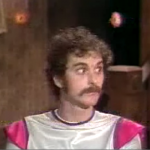 Interview with a Martian (1977)
Interview with a Martian (1977)
Television interview, circa 1977, with Howard K. Martian.
Social Media
WELL Party, 1989 Part 1 (March 16, 2011)
If you think social media started with Facebook, you might be interested in this video of a party by a virtual community, The Well, in 1989. WELL Party scenes courtesy of InCA productions, copyright InCA.
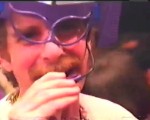
WELL Party, 1989 Part 2 (March 16, 2011)
WELL party video from 1989 (this is Part 2). WELL Party scenes courtesy of InCA productions, copyright InCA.
Network Literacy Part 1 (February 13, 2011)
The first video introduces the importance of understanding networks and explains how the underlying technical architecture of the Internet specifically supports the freedom of network users to innovate.
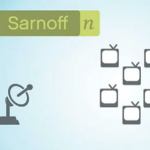 Network Literacy Part 2 (February 113, 2011)
Network Literacy Part 2 (February 113, 2011)
The value of networks shifts as they scale, and as the networks accomodate human social activity as well as interconnection of machines.
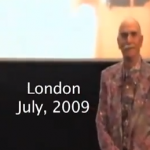 21st Century Literacies (March 2, 2011)
21st Century Literacies (March 2, 2011)
I spoke about 21st century literacies at the Reboot Britain event in London, July, 2009. (About 40 minutes)
Social Media Classroom Screencast (March 3, 2011)
An eight minute description and preview of the Social Media Classroom/Co-laboratory.
Vernacular Video in Culture and Education (March 2, 2011)
This is a broad look at the ways video vernaculars are changing pop culture — and a hint of changes to come in education. Six and a half minutes.
Social Media Classroom: Why Use Forums? (March 2, 2011)
A “why to” video,addressing the need for forums when many people discuss many topics over an extended period.
Why the history of the public sphere matters in the Internet age. (February 15, 2011)
This has been viewed more than 60,000 times. The issues that emerged from print media that led to democracy are very much in play now.
Infotention Part 1 (February 13, 2011)
Mindful infotention is part attentional discipline and part technical skill. This video introduces the mental and technical aspects of information dashboards, radars, and filters. Subsequent installments will provide step-by-step instructions.
Infotention Part 2 (February 13, 2011)
In Infotention Part One, I introduced dashboards, radars, and filters as means for balancing need-to-know with protection against information overload. In this video, the second in the series, I show how to build an information dashboard using an RSS reader. In this case, I concentrate on Netvibes.
Infotention Part Three, (February 13, 2011)
The third of three screencasts on building information dashboards, radars, and filters, using RSS, persistent search, social bookmarking, engagement analysis, and Yahoo Pipes
Interviews by Howard
Interview With Stanford Libraries Curator Henry Lowood (February, 2011)
The word “curation” has been used more and more to refer to the way millions of people select and share information online. I talked with a professional curator of the history of science and technology and film and media at Stanford University libraries.
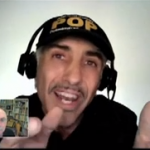
Robin Good on Curation (June 11, ,2011)
I interview Robin Good, that master of new media about curation — what it is, what it requires, why it’s important, how to do it.
 George Siemens on Massive Open Online Courses (MOOCS) (May 5, 2011)
George Siemens on Massive Open Online Courses (MOOCS) (May 5, 2011)
George Siemens, at the Technology Enhanced Knowledge Research Institute at Athabasca University has been running “Massive Open Online Courses” (MOOCs). I talk to him about what a MOOC is, how it works, and the educational philosophy behind it.
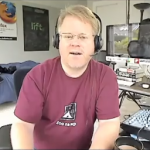 Robert Scoble on Online Curation (March 7, 2011)
Robert Scoble on Online Curation (March 7, 2011)
Increasingly, curation is becoming an important skill for digital citizens. I interviewed Robert Scoble, one of the most prolific and highly knowledgeable curators about how he does what he does and what advice he has for others.
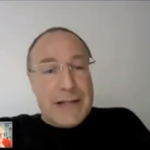 Pierre Levy on Collective Intelligence Literacy (March 5, 2011)
Pierre Levy on Collective Intelligence Literacy (March 5, 2011)
For my book in progress on social media literacies, I talked to Pierre Lévy about his specialty, collective intelligence.
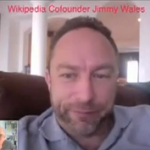 Jimmy Wales on Collaboration Literacy (March 5, 2011)
Jimmy Wales on Collaboration Literacy (March 5, 2011)
In my pursuit of useful lore about social media literacies, I talked with Wikipedia co-founder Jimmy Wales about collaboration skills – how to be a good collaborator, how to convince others to join your collaboration.
Personal
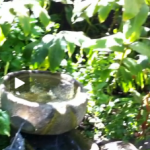 Howard’s Outdoor Office (April 2010)
Howard’s Outdoor Office (April 2010)
I couldn’t resist sharing a quick look at the paradise where I am privileged to sit when I do my work.
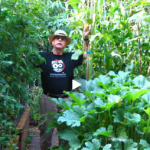
Howard’s Garden (January 23, 2009)
This 7 1/2 minute video is a look at a year in my garden
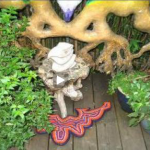 Howard’s Dream Office (March 30, 2009)
Howard’s Dream Office (March 30, 2009)
An audiovisual inspection of the way I’ve reworked the boundaries between work, plan, mind, art, office, studio.
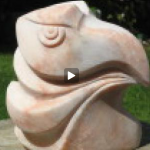 Howard Sculpts Alabaster (March 18, 2009)
Howard Sculpts Alabaster (March 18, 2009)
Short video of Howard Rheingold sculpting alabaster.
